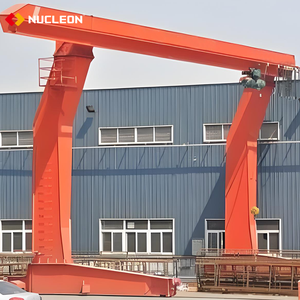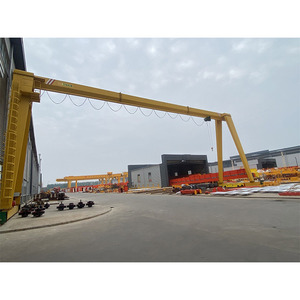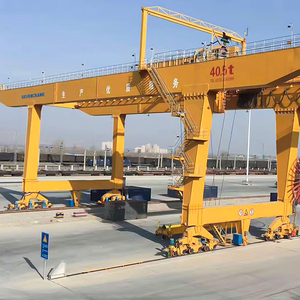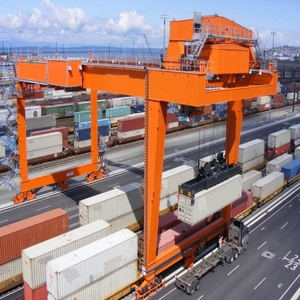
All categories
Featured selections
Trade Assurance
Buyer Central
Help Center
Get the app
Become a supplier

(35537 products available)




















































Market Overview: The global market for rail-mounted gantry (RMG) cranes, including cantilever models, was valued at approximately $2.3 billion in 2023 and is projected to reach $3.1 billion by 2030, reflecting a compound annual growth rate (CAGR) of 4.2% during this period, according to Global Industry Analysts, Inc. Notably, the segment of cranes with a capacity of 0-40 tons is expected to grow substantially, reaching $1.7 billion by 2030 with a CAGR of 3.2%. In contrast, the above 40 tons capacity segment is forecasted to grow at a more robust rate of 5.4%. The U.S. market alone was estimated at $626.5 million in 2023, while China's market is anticipated to grow at an impressive CAGR of 6.9% to reach $634.8 million by 2030, indicating strong regional demand in both established and emerging markets.
Industry Insights: The growth of the RMG cantilever gantry crane market is primarily driven by the increasing global trade and containerized shipping, necessitating efficient cargo handling solutions in ports and intermodal terminals. Technological advancements, such as enhanced automation and energy-efficient designs, are also contributing to market expansion. These cranes are pivotal for improving operational efficiency, reducing turnaround times, and supporting sustainable practices in container handling, as highlighted by recent trends in the industry. However, challenges such as high initial investment costs and fluctuating raw material prices may hinder market growth. Companies are encouraged to pursue innovation, focusing on adaptive systems and partnerships with tech providers to leverage emerging technologies like IoT and AI for enhanced operational capabilities. As the market evolves, stakeholders must navigate these dynamics to capitalize on growth opportunities in the RMG cantilever gantry crane sector.
The RMG cantilever gantry crane is a big crane equipment supported by vertical legs (also known as stanchions/pillars) and cross beams. It is a type of gantry crane that has a horizontal beam (the cantilever) that is supported on one end by the vertical leg. The RMG cranes are designed to lift contemporary containers from vessels to designated areas within the terminal and vice versa.
The following list outlines the most popular types of RMG cranes:
Stack RMG:
The stack RMG crane is a standard type of RMG crane that is used in container terminals with stacks setup. It has the ability to handle containers on vessels as well as in storage stacks. The crane is designed with a maneuverable gantry that can pick containers from their points, and put them down in prescribed locations or even move them horizontally.
Quay RMG:
The Quay RMG crane is usually placed parallel to the shoreline and used for offloading containers from ships to the port and vice versa. This RMG crane lifts containers from ships and places them directly on trucks, vessels, or inland transports that are waiting at the port. Many ports use them to facilitate quick and cost-effective turnaround of ships.
Flexible RMG:
The Flexible RMG crane is designed to adapt to different container setups. It can be used in multi-modal transport terminals where containers have to be transferred between different types of transport modes (like from a ship to a truck or a train). The RMG crane can be reconfigured to accommodate various terminal layouts and operational demands.
Here are some common RMG crane specifications to consider for the buying table:
Capacity
The capacity of an RMG gantry crane indicates the maximum weight of containers it can lift and transfer. RM cranes with 50 ton to 200 ton capacity are common.
Span
The span of a crane is the horizontal distance between its supporting legs. Span values will depend on the width of the stacking yard or wharf. Typical RMG crane spans range between 10 to 20 meters.
Hoisting system
The type of hoist used in an RMG crane affects its speed and weight capacity. Many cranes use wire rope hoists that have been designed for container handling.
Rail/Ground running
Some RMG cranes run with rails, while others run on the ground, depending on the support platform. Ground running cranes are suitable for off-road tough terrains and transfer container at ports. Rail RMG cranes travel on tracks embedded on the ground.
Control System
The control mechanism determines how operators maneuver RMGCs. Common control mechanisms include cabin, remote and ground controls. An RMG crane with remote control allows operators to manage load movement from a distance.
Power Source
A crane's power source defines how it receives energy to move containers. RMG cranes at ports mainly use electric power from overhead lines and diesel generators. Cranes with diesel generators are suitable for stack yards that are far from electricity infrastructure.
Gantry Design
RMGCs have different designs to accommodate various environments. The gantry structure may be a single or double leg design. A double leg design is more stable and is used for handling containers at the open sea.
Proper RMG crane maintenance increases operating life and reduces downtime. Here are some routine maintenance tips:
Regular Inspections:
Schedule frequent inspections to look for signs of damage or wear. Have a qualified technician check the hoist, tires, brakes, tracks and other crane parts. Early repair of faulty components can prevent accidents from occurring.
Lubrication:
Lubricate moving parts of the RMG crane regularly. Follow the manufacturer's manual to use the right lubricant. Regular lubrication reduces friction and prevents premature wear.
Operational Training:
Provide training for employees who operate the crane. Proper operation will prevent damage that occurs due to overloading and improper handling.
Maintain Records:
Keep a log of inspections and maintenance tasks. Document the crane’s repair history. This information helps identify areas that need routine maintenance. It also aids in the scheduling of timely inspections.
The following are several uses for the rmg gantry crane in port logistics, marine engineering, shipbuilding, construction, and other related industries.
Container loading and unloading
Gantry cranes with rails or AGVs may be used for container handling, loading, and unloading operations in terminals, ports, and container yards. They transfer containers from ships to vehicles or storage places securely and swiftly.
Stacking and Storage Management
In container yards or warehouses, RMG cranes can stack containers, manage them, and do sorting and retrieval operations. They can be utilized as automated GMSs when paired with intelligent control systems to manage and organize containers quickly, enhancing storage efficiency and space utilization.
Ship Building
In ship constructing facilities like shipyards, RMG gantry cranes can transport ship parts (like hull sections, decks, and engines) or heavy equipment (like propellers and turbines) to various locations. They can also be used for the assembly and installation of ship sections.
Marine Engineering
In marine engineering operations, RMG gantry cranes can be employed for assembly, disassembly, installation, and maintenance of offshore platforms, wind power equipment, underwater pipelines, and other marine structures.
Separation and Transfer of Goods
RMG cranes may separate and transfer various products (e.g., bulk goods, liquids, and granules) at ports, docks, and terminals, such as bulk cargo handling, transfer operations, and terminal freight access.
Coastal and Port Infrastructure Construction
Coastal and port infrastructure construction (e.g., breakwaters, piers, jetties, and mooring systems) can use RMG cranes for heavy equipment and construction materials transportation and installation.
Maintenance and Repair
In marine and offshore facilities (e.g. docks, ship maintenance yards and repair workshops, RMG cranes can be used for the maintenance and repair of vessels and offshore equipment. They will assist the replacement of components, equipment and the ship to be repaired or maintained to the work platforms.
There are several factors to consider when purchasing RMG cranes for a specific application. Here are some of the most important ones:
Working Environment
Purchasers should carefully examine the working surroundings where the crane will be installed. This includes the open-air yard/land, temperature range, humidity level, and presence of corrosion, dust, or exposed flammable elements. Relying on this, buyers need to choose an RMG crane that can withstand their environment. For example, a climate with constant rains and exposure to marine environments requires a robust anti-corrosive crane. This is ultimately to ensure longevity and performance.
Load Requirements
More importantly, buyers need to consider the weight and size of the goods to be moved. Also, consider the lifting height and range required for the application. By doing this, it will be necessary to determine the crane's capacity. RMG cranes are designed to handle specific maximum loads. Hence, it is important to choose a model that can handle the weight of the goods to be lifted.
Power Supply
Selecting the appropriate RMG crane according to the power source is very important as well. RMG cranes are usually powered by rail cranes, trolley cranes, or container cranes. The right choice ensures smooth operation and minimal downtime.
Budget
Decline by considering one's budget when purchasing an RMG crane. It is crucial to consider the balance between cost and quality. Irrespective of the budget, it is fundamental to invest in a crane that will give good returns in terms of performance and durability.
Q1: How does an RMG crane work?
A1: RMG cranes have two robust bridge beams and a cross-girder that forms the load-bearing structure. The crane may have two or four main wheels running along the track. The crane components are moved by electric drives.
Q2: What is the difference between RMQ and RMG cranes?
A2: An RQM (rail-mounted cantilever crane) is supported on rails fixed to the ground. An RMG (rail and cantilever gantry crane) is supported by rails mounted on stork work, which makes it possible to move the crane in locations with no ground rail.
Q3: What is the difference between a gantry and a hub crane?
A3: Gantry cranes have vertical supports that form a frame running on parallel rails. The load-bearing structure is suspended from this frame. Gantry cranes are suitable for handling large, heavy items over long distances. Hub cranes are more suitable for moving bulk materials. SThey are typically mounted on a central tower and supported by radial limbs, which allow the crane to move in a circular pattern over stockpiles.